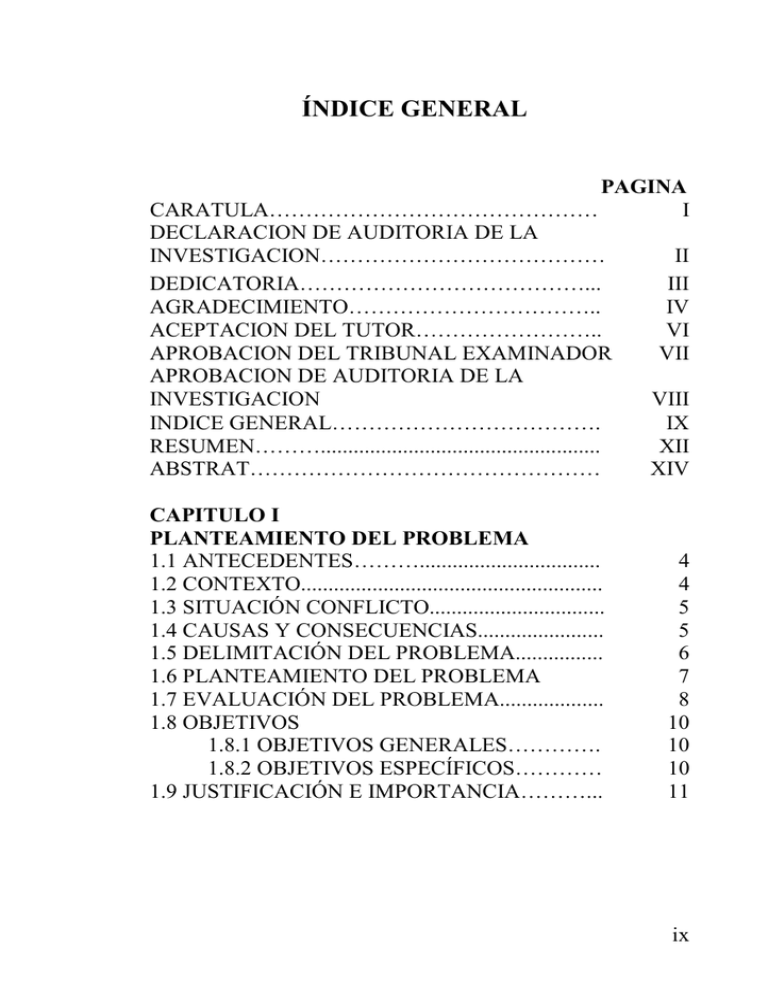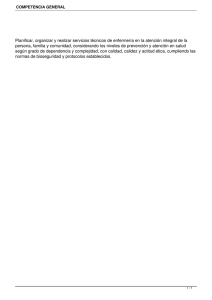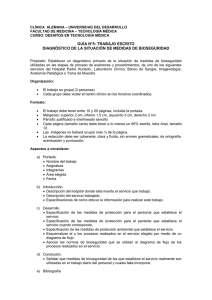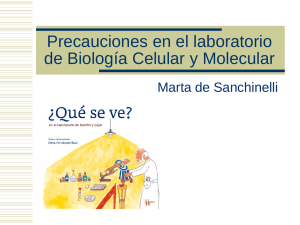LOOR VERA indice.pdf
Anuncio

ÍNDICE GENERAL PAGINA CARATULA……………………………………… I DECLARACION DE AUDITORIA DE LA INVESTIGACION………………………………… II DEDICATORIA…………………………………... III AGRADECIMIENTO…………………………….. IV ACEPTACION DEL TUTOR…………………….. VI APROBACION DEL TRIBUNAL EXAMINADOR VII APROBACION DE AUDITORIA DE LA VIII INVESTIGACION INDICE GENERAL………………………………. IX RESUMEN………................................................... XII ABSTRAT………………………………………… XIV CAPITULO I PLANTEAMIENTO DEL PROBLEMA 1.1 ANTECEDENTES………................................. 1.2 CONTEXTO....................................................... 1.3 SITUACIÓN CONFLICTO................................ 1.4 CAUSAS Y CONSECUENCIAS....................... 1.5 DELIMITACIÓN DEL PROBLEMA................ 1.6 PLANTEAMIENTO DEL PROBLEMA 1.7 EVALUACIÓN DEL PROBLEMA................... 1.8 OBJETIVOS 1.8.1 OBJETIVOS GENERALES…………. 1.8.2 OBJETIVOS ESPECÍFICOS………… 1.9 JUSTIFICACIÓN E IMPORTANCIA………... 4 4 5 5 6 7 8 10 10 10 11 ix CAPITULO II MARCO TEÓRICO 13 2.1 ANTECEDENTES DEL ESTUDIO………..…. 2.1.1 ESFUERZO EN CONJUNTO DE INSTITUCIONES...……………… 2.1.2 ORGANIZACIÓN PANAMERICA DE LA SALUD (NOVIEMBRE 2004)………… 2.13 EL CONGRESO POR LA SALUD Y LA VIDA EN GUAYAQUIL…………………… 2.1.4 DECRETO SUPREMA N188/158…… 2.1.5 CUIDADO CON LAS RADIACIONES 2.1.6 PROTECION DEL PACIENTE……… 2.1.7 PROTECCION DEL OPERADOR…... 2.2 FUNDAMENTACION TEORICA DE BIOSEGURIDAD………………………….. 2.2.1 CONCEPTO………………………….. 2.2.2 GENERALIDADES………………….. 2.2.3 RESUMEN PRINCIPIOS DE BIOSEGURIDAD………………………….. 2.3 HIPOTESIS………………………………… 2.4 VARIABLES………………………………. 3.1 3.2 3.3 3.4 x CAPITULO III METODOLOGIA DISEÑO DE LA INVESTIGACION 3.1.1 AREA DE ESTUDIO………………… 3.1.2 MATERIALES Y METODOS……….. PLAN DE TABULACION Y ANALISIS….. POBLACION Y MUESTRA………………. 3.3.1 CRITERIOS DE INCLUSION……….. 3.3.2 CRITERIOS DE EXCLUSION………. OPERACIONABILIDAD DE VARIABLES 14 14 16 16 17 18 18 19 19 19 20 44 44 45 45 46 47 49 49 50 CAPITULO IV CRONOGRAMA Y PRESUPUESTO 4.1 MARCO ADMINISTRATIVO…………….. 4.2 PRESUPUESTO…………………………..... 4.2.1 PERSONAL…………………………... 4.2.2 MATERIALES Y EQUIPOS………… 4.2.3 OTROS……………………………….. 61 62 63 63 CAPITULO V ANALISIS E INTERPRETACION DE LOS RESULTADOS 5.1 DESCRIPCION DE RESULTADOS………. 5.2 PRINCIPIOS DE UNIVERSALIDAD……... 65 69 CAPITULO VI CONCLUSIONES Y RECOMENDACIONES 6.1 CONCLUSIONES………………………….. 6.2 RECOMENDACIONES……………………. 6.3 REFERNCIAS BIBLIOGRAFICAS……….. 6.4 ANEXOS…………………………………… 6.5 BIBLIOGRAFIAS………………………….. 75 78 79 80 91 xi UNIVERSIDAD DE GUAYAQUIL FACULTAD PILOTO DE ODONTOLOGÍA ESCUELA DE POSTGRADO ESPECIALIDAD ENDODONCIA. CONOCIMIENTO Y PRÁCTICAS DE LAS MEDIDAS DE BIOSEGURIDAD DE LOS ODONTÓLOGOS DE LAS PROVINCIAS DE IMBABURA, CARCHI Y BOLIVAR Autor: Doctora En Odontología Lia Josefina Loor Vera. Tutor: Dr. Abdón Sánchez Cifuentes RESUMEN El proyecto: “Conocimiento y prácticas de las medidas de bioseguridad de los odontólogos de las provincias del Imbabura, Carchi y Bolívar”, respondió a la necesidad de evaluar los procedimientos de bioseguridad usados en la atención primaria de salud oral en los consultorios odontológicos de esa zona del país, los cuales sumados a investigaciones de iguales características de las demás provincias, permitirá tener un referente estadístico a nivel nacional de las condiciones de bioseguridad en las que se desenvuelven las unidades operativas de odontología. La responsabilidad profesional de conocer y aplicar métodos de bioseguridad, es un requerimiento fundamental en los programas de atención odontológica, debido a los riesgos muy altos de contaminación antes, durante y después de cualquier procedimiento asistencial, ya que se maneja sustancias químicas radioactivas y fluidos corporales altamente contaminantes, la exposición a los mismos, se da de manera secuencial y permanente. La cavidad oral, es portadora y receptora de la mayor cantidad de microorganismos patógenos causantes de enfermedades infectocontagiosas focales y xii sistémicas, requiriendo que los profesionales adopten rigurosas medidas de bioseguridad preventivas que contemplen: Conocimientos actualizados de bioseguridad, infraestructura física y técnica optima, los principios de universalidad relacionados al echo cierto que todo paciente es un potencial contaminante, manejo técnico y adecuado de los desechos, uso adecuado de las técnicas de barrera. La investigación por ser un estudio sin precedentes en el Ecuador, permitirá aportar con datos reales y actualizados sobre las prácticas de bioseguridad de los profesionales de odontología. El diseño metodológico del proyecto de investigación corresponde a un estudio descriptivo transversal cuantitativo y cualitativo. La técnica de recolección de datos se realiza mediante la observación, entrevistas y encuestas. El universo corresponde a los odontólogos federados que prestan sus servicios en las unidades operativas del ministerio de salud, seguro social y organizaciones no gubernamentales que prestan servicios en la comunidad. Palabra clave: Bioseguridad, exposición, contaminación xiii UNIVERSIDAD DE GUAYAQUIL FACULTAD PILOTO DE ODONTOLOGÍA ESCUELA DE POSTGRADO ESPECIALIDAD ENDODONCIA. CONOCIMIENTO Y PRÁCTICAS DE LAS MEDIDAS BIOSEGURIDAD DE LOS ODONTÓLOGOS DE LAS PROVINCIAS DE IMBABURA, CARCHI Y BOLIVAR Autor: Doctora En Odontología Lia Josefina Loor Vera. Tutor: Dr. Abdón Sánchez Cifuentes Abstract The project: Knowledge and Practices of Biosecurity from Dentists of Carchi, Imbabura and Guaranda States Responds to the need to assess the biosecurity procedures used in primary oral health care of the Dental Clinics in the state area. Professional responsibility to understand and apply methods of biosecurity, is a fundamental requirement in the curricula of dental care, due to very high risks of contamination before, during and after any process of care, since it handles chemicals, radiation and Corporal fluids highly contaminated, the exposure is given in sequence and permanent The oral cavity is a carrier and receiving the greatest number of pathogens that cause diseases and systemic focus. The investigation by a study be unprecedented in Ecuador, allows to provide real data and updated on biosecurity practices of dental professionals. The methodological design of the research project is a cross sectional study quantitatively and qualitatively. xiv The technique of data collection was performed by observation, interviews and surveys. The universe went to the federal dentists who provide services in the operational units of the Ministry of Health, Social Security and NonGovernmental Organizations We found that the dentist provide services in extremely high percentage in General Dentistry, knowledge of Biosecurity heterogeneous are having a marked deficits, especially in technical barrier and principles of universality The implementation of procedures for Biosecurity is partly, non-Dentist applies with all biosecurity measures and some of their actions are totally ignored. It follows that the dentist did not have the appropriate knowledge to ensure the adequacy in the management of biosecurity measures, coupled with other factors that prevent compliance with the proper implementation of all its principles xv


